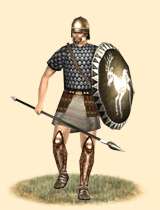Hoplitai Hellenikon (Saka Heavy Hoplites)
 |
Weapons | Defence | Mental | ||||||
|---|---|---|---|---|---|---|---|---|---|
| Primary | Secondary | Armour: | 12 | Morale: | 11 | ||||
| Type: | spear | none | Shield: | 4 | Discipline: | disciplined | |||
| Attack: | 15 | 0 | Skill: | 8 | Training: | highly_trained | |||
| Charge: | 8 | 0 | Recruitment | Other | |||||
| Lethality: | 0.13 | 0.1 | Soldiers: | 40 | Hit Points: | 1 | |||
| Range: | 0 | 0 | Cost: | 1407 | Mass: | 1.22 | |||
| Ammo: | 0 | 0 | Upkeep: | 352 | |||||
| Turns: | 1 | ||||||||

The Hoplitai Hellenikon are a reliable, well armored heavy infantry, designed along Hellenic lines, but tinged with the material preferences of their new Saka rulers.
Hardy
The Hoplitai Hellenikon are an extraordinarilly heavily armored evolution of the ancient Hoplitai of Hellas, combining the traditional Hellenic phalanx with the superb defense afforded by the prefered armor of the Steppes. They are among the most disciplined of infantry forces, lumbering forward under the initial cover of their extended spears, thick helmets, bronze greaves, and massive hoplons, while each man's torso is encased in a heavy suit of scale. Though this almost excessive armor compliment makes them among the least mobile of the Hellenic infantry variations, with a proper position, they are a nearly impenetrable force - and nearly as irresistible when engaged in melee. With the rapid advance of metallurgical techniques in the smithies of Hellenic workmen, the fusion of Hellenic order and discipline with Steppe scale-armor places these Hoplitai far ahead of other infantry with regards to armor; equipped to hold against both the heavily armored cavalry of the East and the eager, heavily armed infantry of the West. Under the right commander, used properly to compliment other units, they are a battle-winning force.
Historically, when the Hellenic and the Steppe cultures and infrastructure met, adaptation ensued. The Hoplitai Hellenikon are one such adaptation; the natural result of the military traditions and designs of both. To the North of the Oxus, the Sakae hordes massed; clad in their superb armor, while to the South, the Hellenes prepared their ordered phalanx to meet the furious onslaught with cold discipline. When the Sakae did secure the settled cities of the Hellenes, many were able to maintain a great deal of their Greek culture and most retained the majority of their original population. Though now operating as the suzerain of these new possessions, many Sakae Kings chose to allow older Hellenic governors to retain local posts, permitting them to (to a certain extent) take advantage of the pre-existing Greek military infrastructure. Having wisely maintained the old systems, they could then draw on some of their Hellenic subjects as regular soldiers, calling on local Hellenic meridarchs or even the petty princelings or rajakumara of tiny hill kingdoms in the South-East to levy them on their behalf.